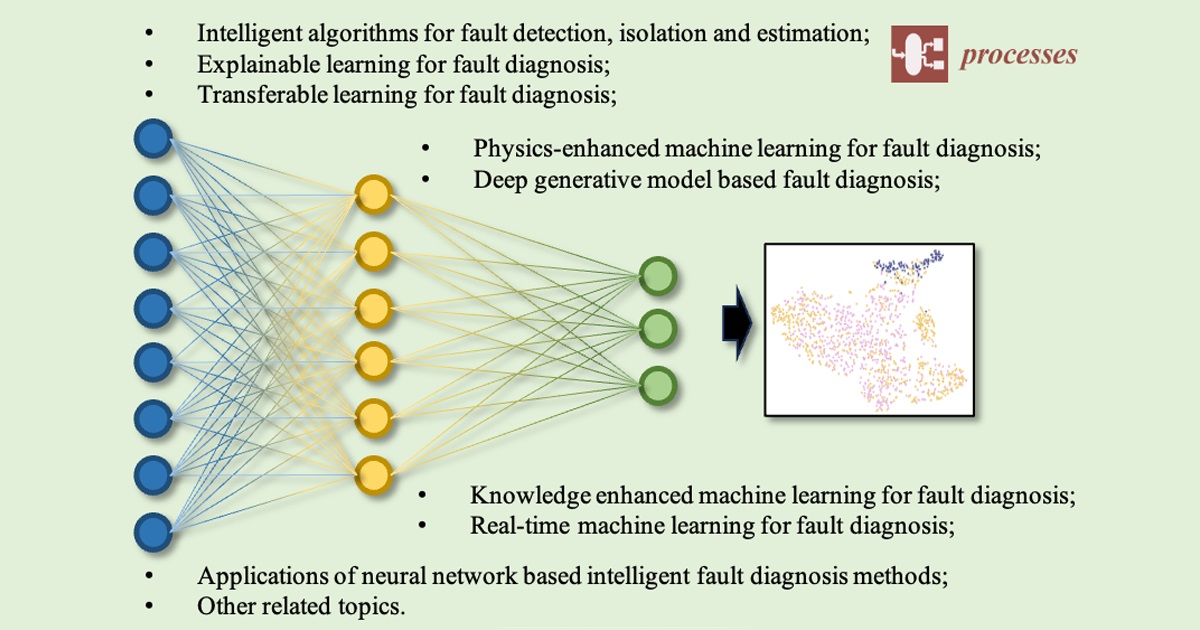Research on Intelligent Fault Diagnosis Based on Neural Network
A special issue of Processes (ISSN 2227-9717). This special issue belongs to the section "Automation Control Systems".
Deadline for manuscript submissions: closed (1 February 2025) | Viewed by 5637

Special Issue Editors
Interests: fault diagnosis; remaining useful life prediction; state estimation
Interests: fault diagnosis and prediction; deep learning; feature extraction and decision fusion; intelligent detection and predictive control of abnormal working conditions; state detection and feature extraction
Special Issue Information
Dear Colleagues,
Fault diagnosis for complex systems and components has been attracting considerable attention from researchers and engineers, which has greatly contributed to the safety and reliability of various kind of engineering systems. Recent decades have witnessed tremendous success in artificial intelligence- and neural network-related techniques and applications, which has also aroused significant research interests in the field of fault diagnosis. Numerous intelligent fault diagnosis methods have been proposed based on neural networks, achieving great success in diagnostic performance improvement.
This Special Issue on “Research on Intelligent Fault Diagnosis Based on Neural Network” aims to further advance intelligent fault diagnosis methods based on neural network technology and address existing problems in this field. Topics of interest include, but are not limited to, the following:
- Intelligent algorithms for fault detection, isolation, and estimation;
- Explainable learning for fault diagnosis;
- Transferable learning for fault diagnosis;
- Physics-enhanced machine learning for fault diagnosis;
- Deep generative model-based fault diagnosis;
- Knowledge-enhanced machine learning for fault diagnosis;
- Real-time machine learning for fault diagnosis;
- Applications of neural network-based intelligent fault diagnosis methods;
- Fault-tolerant control;
- Remaining useful life prediction;
- Intelligent maintenance strategies;
- Other related topics.
Dr. Yanyan Hu
Prof. Dr. Lifeng Wu
Guest Editors
Manuscript Submission Information
Manuscripts should be submitted online at www.mdpi.com by registering and logging in to this website. Once you are registered, click here to go to the submission form. Manuscripts can be submitted until the deadline. All submissions that pass pre-check are peer-reviewed. Accepted papers will be published continuously in the journal (as soon as accepted) and will be listed together on the special issue website. Research articles, review articles as well as short communications are invited. For planned papers, a title and short abstract (about 100 words) can be sent to the Editorial Office for announcement on this website.
Submitted manuscripts should not have been published previously, nor be under consideration for publication elsewhere (except conference proceedings papers). All manuscripts are thoroughly refereed through a single-blind peer-review process. A guide for authors and other relevant information for submission of manuscripts is available on the Instructions for Authors page. Processes is an international peer-reviewed open access monthly journal published by MDPI.
Please visit the Instructions for Authors page before submitting a manuscript. The Article Processing Charge (APC) for publication in this open access journal is 2400 CHF (Swiss Francs). Submitted papers should be well formatted and use good English. Authors may use MDPI's English editing service prior to publication or during author revisions.
Keywords
- intelligent fault diagnosis
- neural networks
- machine learning
- fault-tolerant control
- remaining useful life prediction
- intelligent maintenance
Benefits of Publishing in a Special Issue
- Ease of navigation: Grouping papers by topic helps scholars navigate broad scope journals more efficiently.
- Greater discoverability: Special Issues support the reach and impact of scientific research. Articles in Special Issues are more discoverable and cited more frequently.
- Expansion of research network: Special Issues facilitate connections among authors, fostering scientific collaborations.
- External promotion: Articles in Special Issues are often promoted through the journal's social media, increasing their visibility.
- e-Book format: Special Issues with more than 10 articles can be published as dedicated e-books, ensuring wide and rapid dissemination.
Further information on MDPI's Special Issue polices can be found here.






